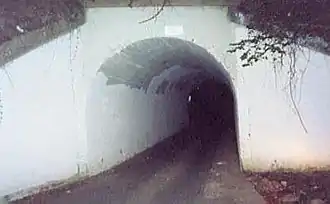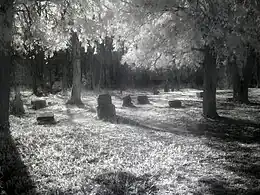Legend tripping
Legend tripping is a name bestowed by folklorists and anthropologists on an adolescent practice (containing elements of a rite of passage) in which a usually furtive nocturnal pilgrimage is made to a site which is alleged to have been the scene of some tragic, horrific, and possibly supernatural event or haunting.[1] The practice mostly involves the visiting of sites endemic to locations identified in local urban legends. Legend tripping has been documented most thoroughly to date in the United States.[2]

Sites for legend trips
While the stories that attach to the sites of legend tripping vary from place to place, and sometimes contain a kernel of historical truth, there are a number of motifs and recurring themes in the legends and the sites. Abandoned buildings, remote bridges, tunnels, caves, rural roads, specific woods or other uninhabited (or semi-uninhabited) areas, and especially cemeteries are frequent sites of legend-tripping pilgrimages.
Reactions and controversies

Legend-tripping is a mostly harmless, perhaps even beneficial, youth recreation. It allows young people to demonstrate their courage in a place where the actual physical risk is likely slight.[3] However, in what Ellis calls "ostensive abuse," the rituals enacted at the legend-tripping sites sometimes involve trespassing, vandalism, and other misdemeanors, and sometimes acts of animal sacrifice or other blood ritual.[4] These transgressions then sometimes lead to local moral panics that involve adults in the community, and sometimes even the mass media. These panics often further embellish the prestige of the legend trip to the adolescent mind.[3] In at least one notorious case, years of destructive legend-tripping, amounting to an "ostensive frenzy," led to the fatal shooting of a legend-tripper near Lincoln, Nebraska followed by the wounding of the woman whose house had become the focus of the ostension.[5] The panic over youth Satanism in the 1980s was fueled in part by graffiti and other ritual activities engaged in by legend-tripping youths.[3]
Associated places in the United States
- The Baird Chair monument in Kirksville, Missouri[6]
- Bachelor's Grove Cemetery, outside of Chicago, Cook County, Illinois[7]
- The Black Agnes statue, formerly in Pikesville, Maryland and now in Washington, DC[8]
- The Black Angel monument at Oakland Cemetery in Iowa City, Iowa.
- Bunny Man Bridge near Clifton, Virginia[9][10]
- Crawford Road in Yorktown, Virginia[11]
- Devil's Tramping Ground south of Siler City, North Carolina, near Harper's Crossroads.
- Goat Man's Grave near Rolla, Missouri.[12]
- Hexenkopf Rock in Williams Township, Pennsylvania[13]

- The Hornet Spook Light twelve miles southwest of Joplin, Missouri[14]
- The Lake View Public School, also known as the Gore Orphanage, near Cleveland, Ohio[15][16]
- McHarry, Captain Frances burial spot in Harrison County, Indiana[17]
- Manteno State Hospital in Manteno, Illinois
- Mudhouse Mansion in Fairfield County, Ohio
- The Myrtle Hill Cemetery in Medina County, Ohio[18]
- New Jersey Pine Barrens, said to be home to the Jersey Devil
- Old Alton Bridge south of Denton, Texas
- Old Louisville, reported to be the most haunted neighborhood in the United States
- Ong's Hat, New Jersey[19]
- Our Lady of the Angels School in Chicago, Illinois and its Fire Memorial in nearby Queen of Heaven Cemetery.[20]
- The Pope Lick Trestle in Louisville, Kentucky, home to the satyr-like Pope Lick Monster
- Rehmeyer's Hollow in Shrewsbury, Pennsylvania
- Satansville on Cossart Road near Chadds Ford, Pennsylvania
- Stull Cemetery in Stull, Kansas, claimed to be a "gateway to Hell"[21]
- Sweet Hollow Road and Mount Misery Road in Huntington, New York
- Waverly Hills Sanatorium, an abandoned hospital for tuberculosis victims, in Louisville, Kentucky[22][23]
See also
References
- "Legend trip", entry in American Folklore: An Encyclopedia, ed. Jan Harold Brunvand (1996) ISBN 0-8153-3350-1
- Peter Monaghan, "The Surprising Online Life of Legends" The Chronicle of Higher Education Dec 12, 2011
- Ellis, Bill. "Legend Trips and Satanism: Adolescents' Ostensive Traditions as 'Cult' Activity." In The Satanism Scare, ed. James T. Richardson, Joel Best, and David G. Bromley, 279-95. NY: Aldme DeGreyter
- Ellis, Bill (July 1989). "Death by Folklore: Ostension, Contemporary Legend, and Murder". Western Folklore. 48 (3): 201–220. doi:10.2307/1499739. JSTOR 1499739.
- Summers, Wynne, L. "Bloody Mary: When Ostension Becomes a Deadly and Destructive Teen Ritual." Midwestern Folklore 26 (2000):1 19-26.
- "The Devil's Chair". October 3, 1996. Archived from the original on August 20, 2006.
- Bachelor’s Grove Cemetery is the most haunted graveyard in America; article; Roadtrippers; Accessed 25 June 2022
- Mikkelson, David (5 November 2000). "Black Agnes". Snopes.
- "The Truth About Bunnyman Bridge". Center for Paranormal Research.
- Brian A. Conley. "The Bunny Man Unmasked – Fairfax County, Virginia". Fairfax County Public Library. Archived from the original on 2011-10-30. Retrieved 2016-05-12.
- "Crawford Road - Colonial Ghosts". 2017-08-15. Retrieved 2022-05-28.
- Tremeear, Janice (16 August 2011). Haunted Ozarks. Arcadia Publishing. ISBN 978-1625841735.
- "Hexenkopf: The Witch's Head". horrorfind.com. Archived from the original on 2013-01-26.
- "The Hornet Spook Light". prairieghosts.com.
- "The Gore Orphanage". Forgotten Ohio.
- Legend Tripping in Ohio: The Gore Orphanage
- "Captain McHarry's Vault – New Albany, IN – Weird Story Locations on Waymarking.com". Waymarking.com.
- "The Witch's Ball of Myrtle Hill Cemetery". Forgotten Ohio.
- Kinsella, Michael (2011). Legend-Tripping Online: Supernatural Folklore and the Search for Ong's Hat. Jackson, MS: University Press of Mississippi. ISBN 978-1604739831.
- "Our Lady of the Angels School Fire December 1, 1958 Chicago Illinois".
- "Stull Cemetery! One of the Seven Gateways to Hell?". prairieghosts.com.
- "The Waverly Hills Sanatorium". Archived from the original on 2004-04-02. Retrieved 2004-04-22.
- Ohio Trespassers – Ohio legends & Waverly Hills
Further reading
- Aliens, Ghosts, and Cults: Legends We Live, by Bill Ellis (2001) ISBN 1-57806-325-6
- Encyclopedia of Haunted Indiana, Kobrowski, Nicole, 2008. ISBN 978-0-9774130-2-7
- Legend Tripping: A Contemporary Legend Casebook. Logan: Utah State University Press; McNeill, Lynne S. and Elizabeth Tucker, eds.; 2018.
- Legend-Tripping Online: Supernatural Folklore and the Search for Ong's Hat, Michael Kinsella, (2011) ISBN 978-1604739831
- "Legend Tripping: The Ultimate Family Experience, Robinson, Robert C., 2014. ISBN 978-1-889137-60-5
- Lucifer Ascending: The Occult in Folklore and Popular Culture, by Bill Ellis (2004) ISBN 0-8131-2289-9
- Raising the Devil: Satanism, New Religions, and the Media, by Bill Ellis (2000) ISBN 0-8131-2170-1
- Fine, Gary Alan (Spring 1991). "Redemption Rumors and the Power of Ostension". The Journal of American Folklore. 104 (412): 179–181. doi:10.2307/541227. JSTOR 541227.
- What's in a coin? Reading the Material Culture of Legend Tripping and Other Activities (2007), by Donald H. Holly and Casey E. Cordy. The Journal of American Folklore 120 (477):335-354.